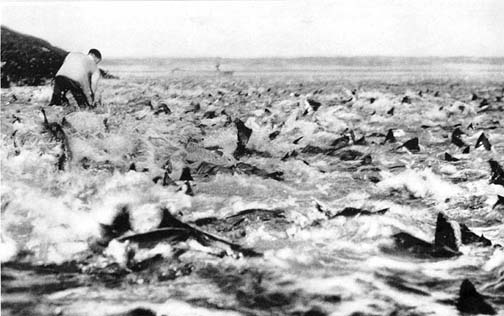
"Ninety Percent" Vindication for Mexico's
Embattled Fisheries
![]()
|
THE PRISTINE SEA--An otherworldly photo by Jake Miller of giant totoaba crashing the beach in the northern Sea of Cortez, Mexico, ca. 1930. How much has the fishery really declined? Ninety percent seems a conservative estimate. |
RECENT STUDIES CONFIRM A FISHERMAN'S SUSPICIONS ABOUT
THE DECLINE IN MEXICO'S MARINE FISHERIES
By Gene Kira, May 26, 2003, as published in Western Outdoor News:
Two of the most dumbfounding moments I've ever had occurred during conversations about fisheries matters with Mexican officials.
The first happened a few years ago in San Felipe, when a staff member from the Department of Fisheries office in Ensenada said with complete seriousness:
"The problem with fish depletion on the Pacific coast is that there is too much sport fishing between Ensenada and Punta Eugenia."
Not trusting my Spanish, I asked her to repeat it twice. Yup. That's what she said, all right. But considering the virtually invisible amount of sport fishing along Baja's entire Pacific coast, to this day, I'm not exactly sure what she was talking about. The really scary part is that these are the people in charge of Mexico's fishing regulations and permits.
|
|
But that ain't nothin' compared to a meeting I had in Mexico City with an elegantly dressed member of Mexico's governing elite, an official in the Department of Natural Resources, which is supposed to be in charge of protected areas, endangered species, and so forth.
Admittedly, I was pushing it a bit, and I might have even pounded on the table a little, but I wanted to wake this out-of-touch bureaucrat up to the fact that the fishery is down, way, way down, and Mexico must wake up and do something about it before it's too late.
This official looked at me with a supercilious smile and asked, "And, how far down do you think it is?"
I replied in the calmest tones I could muster that, since I first visited in 1963, I have watched--with my own two eyes--the general supply of fish in the Sea of Cortez decline by what I guessed was about 90 percent.
Again came the supercilious smile, and he asked, "And what scientific data do you base your estimate on?"
I don't remember what I said, but I'll never forget that smile, and the sudden realization that this influential politician didn't believe me. And once again, the scary thing is that these are the people in charge of Mexico's fisheries policy.
Well, amigos, last week the Washington Post published an article about a recent research paper that puts the Big Lie to anyone, anywhere who says that we don't have a fisheries crisis going on, and I felt particularly vindicated by the paper's scientific estimate of fisheries declines: 90 percent.
|
|
This watershed paper was written by Ransom Myers and Boris Worm of Dalhousie University in Halifax, Nova Scotia, after a study of global fisheries records going back half a century. This was the first study to analyze historical catch data from the 1950s when large-scale industrial fishing was first becoming prevalent.
Every fishery studied showed catastrophic declines, particularly those impacted by longlining. Fish populations were destroyed very quickly. For instance, early longline catch records showed that the average catch dropped 90 percent--from 10 fish per 100 hooks, to 1 fish--in the first ten years of fishing.
Trawlers in the Gulf of Thailand saw a 60 percent drop in five years, and at one location in the South Atlantic, virtually all targeted fish disappeared in only two years.
Another important point made by Myers and Worm was that reports of fisheries "recoveries" are often based on an already degraded "baseline" from perhaps only ten years ago, when the stock was already decimated. The so-called "recovered" fishery might still be drastically depleted compared to its truly pristine state.
All of this data corresponds with my admittedly stumblebum, anecdotal personal observations, and I am now much more confident that I've been seeing what I've been seeing.
In addition, I've interviewed many old fishermen, who say that parts of the Cortez were already decimated by the time I first saw it in 1963. If that's true, and if I've seen a 90 percent drop myself, how large is the real decline? Could it be 95 percent, or even more? Fishing was so incredibly abundant in 1963, I really can't imagine what it must have been like originally. I really can't.
(Related Mexico articles and reports may be found at Mexfish.com's main Mexico information page. See weekly fishing news, photos, and reports from the major sportfishing vacation areas of Mexico including the Mexico area in "Mexico Fishing News.")
MEXICO FISHING INFO MEXICO FISHING INFO "WEEKLY MEXICO FISHING NEWS" FISH PHOTO GALLERY
